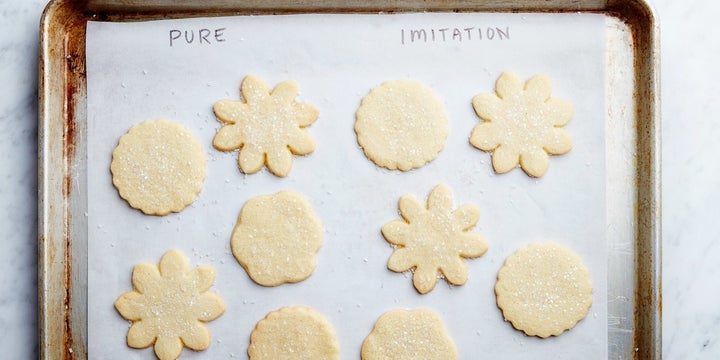For Epicurious, by Joe Sevier.

Before I went to actual cooking school, I went to the school of Martha Stewart. (Disclaimer: That’s not an actual school.) From my couch, I learned that when baking it was crucial to always use the finest ingredients, the best vanilla extract I could find, and if at all possible, freshly laid eggs from Martha’s own farm. I’m still working on securing that last one.
But in her book, Eight Flavors: The Untold Story of American Cuisine, culinary historian Sarah Lohman makes the argument that there are times when imitation vanilla extract is actually preferable to pure. 😮 “I believe there is a time and place to use every version of vanilla in your kitchen: Bean, natural extract, and imitation extract,” she writes. Vanillin is the naturally occurring chemical compound that we recognize as the primary aroma and taste of vanilla. And although real vanilla extract is made up of vanillin (plus lesser compounds that add to its varying levels of complexity), sometimes the vanillin is all you need to spark that familiar flavor.
To prove her point, Lohman conducted a taste test at the Brooklyn Brainery, a hub for recreational adult classes and workshops. She baked two sets of cookies, one with real vanilla extract and one with imitation. The audience preferred the imitation cookies 2:1. The reason, Lohman says, is that all the little compounds that make up that complex natural vanilla flavor can’t survive high-heat cooking, and so add little to cookies — which cook to an internal temperature of about 300°F. Using imitation vanilla extract, a product made of synthetic vanillin, results in a cookie with more pronounced flavor.
Needless to say, the Epi Test Kitchen was still dubious. So we conducted our own blind taste test. Our test kitchen assistant, Kat Boytsova, baked two batches of our All-in-One Sugar Cookies: one with Spice Supreme Imitation Vanilla Extract and the other with Nielsen-Massey Madagascar Bourbon Pure Vanilla Extract (the real deal). My colleague Kat Sacks, a former restaurant pastry cook, and I both picked Batch B as the favorite. The remaining tasters could detect no difference in sight, smell, or taste between the two batches. So what was Batch B? Imitation. Cue the dramatic shocked montage.
Which is not to say that we should all toss our $40 stash of vanilla beans. Lohman recommends using vanilla beans for puddings and custards, which cook to a much lower temperature. She also cites a similar test from America’s Test Kitchen in which imitation vanilla tied with natural vanilla in a cake bake-off, but prefers using real vanilla for her own cakes. As for Lohman’s cookies, however — and ours — they will never be the same. They’ll be better. Cheaper, too. And that’s a good thing.
Get the recipe: All-in-One Sugar Cookie Dough
More from Epicurious:
